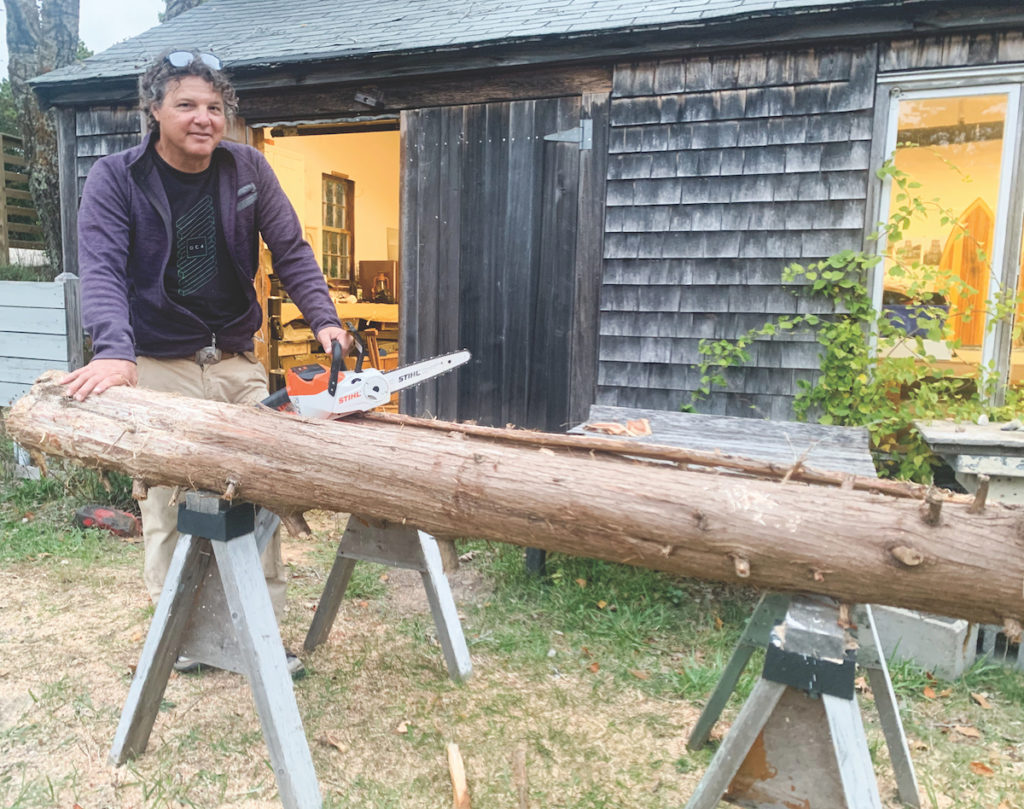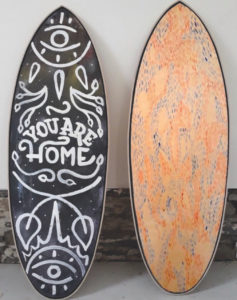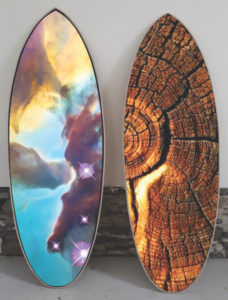
“Everything I do, I do because I love nature, because I want to be connected to nature. That guides every decision in my life,” says Rich Blundell. He has come to the Truro Center for the Arts at Castle Hill to work on his handmade wooden surfboard sculptures, using local cedar wood. It’s part of a journey he’s making to introduce artists to the principles of “ecological intelligence.”
Blundell’s deep connection to the Earth and the environment was born in the woods, sand, and waters of Cape Cod. Though he grew up across the bay, in Duxbury, he spent his childhood summers here, swimming and surfing in the ocean and exploring hidden paths between the ponds, pines, and cedars. After traveling the world to study and teach science — Blundell has a geology and biology degree, a master’s in the history and philosophy of science, and a Ph.D. in “big history,” a field that explores humanity’s relationship to the evolution of the cosmos — he chose this residency as a way of returning to the place he calls his natural home.
“I’m very connected to the diverse ecosystems here — the grit of this soil, the way pine needles dry, and the mixing of salt and fresh water,” he says. “There is something about the particular chemistry of this place that is unique.”
To Blundell, both art and surfing are ecstatic practices. As an artist, he creates two distinct types of surfboards: the first are meticulously crafted wooden boards intended for surfing, and are built using his own “retro-designs.” They are shaped differently and are heavier than modern high-performance boards, and they teach surfers to be attuned to the subtle cues of each wave as it moves from the horizon toward the shore. These functional surfboards “provide a special kind of living glide, and Cape Cod trees seem to glide best down Cape Cod waves,” he says. “There is just something spiritual that happens when local wood, water, and waves come together.”

Blundell also makes simpler surfboards that are explicitly artworks — a canvas onto which he and, possibly, other artists in collaboration “manifest or express ecological intelligence.” The piece titled You Are Home, for example, was created in collaboration with Chelsea Arruda, who had taken one of the classes for artists in Blundell’s education program, Oika. Named after the Greek word oikos, meaning “house” or “home,” the root of the prefix “eco-,” Blundell’s program “aims to re-establish the link between economy and ecology” and a “feeling of belonging that can inspire creativity in artists.”
Blundell believes that artists often have a heightened sensitivity, even though they may not be aware of it, that uniquely positions them to bring an understanding of nature back into the culture. By teaching artists to recognize this, he feels they can achieve a shift in “the climate of our minds” that will save us from destroying the planet.
“Artists have forgotten that they are the essential meaning-makers,” Blundell says. “That’s what we need in order to heal the many intertwined traumas we are currently facing. If you look at the history of humans, our species is 150,000 to 300,000 years old, and for 99.9 percent of that time we lived in relationship with nature. But we have lost that connection, and now we’re starting to notice that we can’t live without it. It’s intrinsic to all human beings, because we emerge from nature — not just our bodies, but also our creative minds.” In other words, he says, “What artists do is simply an extension of nature’s creativity.”
Blundell is currently working on two projects in his studio on Castle Hill’s Edgewood Farm campus. One is a triptych of three surfboard sculptures that tells the history of the land here. “I’m focusing on the cedar tree and its different manifestations in this habitat,” he says. “Cedars are naturally stained with the minerals of glacial sediments, and the wood grain is guided by living with other trees.”

He points to pieces of wood covered in bark laid out in the shape of a surfboard. “This tree was growing here two days ago,” Blundell says. “Here it is, rough and raw. I’m going to make one surfboard out of this texture, and another using the same wood’s refined and finished texture showing its grain pattern. The third board panel is going to be covered in weathered barn shingles that tell the cultural part of this Cape Cod story.”
Blundell’s second project is based on a Cosmic Duo of surfboards, which explores “how celestial ecologies impinge on the familiar biological ecologies here on Earth.” He says that “not many people know, much less feel, how cosmic-scale events such as colliding galaxies and the supernovae they trigger, or the convergences of neutron stars 144 million light years away, lead to the creation of the atoms in trees and our own bodies. About one tenth of a gram of each human being is made of neutrons that escaped annihilation in a black hole by surfing on gravitational waves to get here. That reality puts current politics into a different perspective.”



